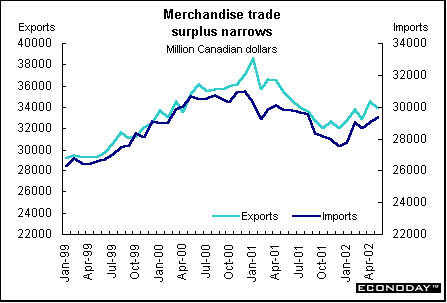
Indicator scoreboard
EMU - May seasonally adjusted industrial output rose 0.1 percent but dropped 1.2 percent when compared with last year. Non-durable consumer goods rose 0.6 percent and 0.6 percent on the year and energy edged up 0.2 percent and 2.7 percent on the year. Capital goods and consumer durable goods output fell by 1.1 percent and intermediate goods declined 0.3 percent. When compared with last year, durable consumer goods output fell 6.8 percent, capital goods were down 5.1 percent, while intermediate goods declined 0.1 percent.

June harmonized index of consumer prices was unchanged but up 2.3 percent when compared with last year. On an annualized basis, the HICP rose 1.8 percent. Prices declined for food, transport, clothing and housing while prices rose for hotels and restaurants as well as alcohol and tobacco. The core HICP, which excludes energy, food, alcohol and tobacco, rose 0.1 percent and 2.5 percent on the year.

Germany - June wholesale prices fell 0.7 percent and 1.5 percent on the year. This was the third month in a row that wholesales prices declined. All WPI price categories declined led by lower seasonal food and energy prices. Excluding seasonal food prices, wholesale prices fell 0.6 percent and 1.5 percent on the year. Energy prices fell 2.7 percent and 6.5 percent on the year. Excluding oil products, wholesale prices fell 0.4 percent and 0.8 percent on the year.
Italy - May seasonally and workday adjusted industrial production rose 1.6 percent after dropping one percent in April and 0.7 percent in March. On the year, industrial production was down 1.6 percent, the eleventh consecutive decline. Consumer goods output rose 4.0 percent, investment goods gained 1.2 percent while intermediate goods increased by 0.6 percent.
May industrial orders dropped 0.7 percent when compared with last year, following an 8.3 percent jump in April. Domestic orders tumbled 2.6 percent but foreign orders jumped 2.3 percent. Domestic orders account for around 62 percent of the overall index, with foreign orders making up about 37 percent.
Britain - May average earnings rose to 3.8 percent from 3.3 percent in April. The increase was largely due to private sector earnings, which rose 3.8 percent compared with 3.1 percent in April. Public sector earnings fell to 3.8 percent from 4.1 percent in April. Service sector earnings rose to 3.8 percent from April's 3.2 percent, of which private sector services jumped to 3.8 percent from 2.9 percent. There was also a pick-up in manufacturing sector pay, to 3.3 percent from 3.0 percent.

June claimant count unemployment rose by 1,300 following a revised drop of 500 in May. The unemployment rate remained at 3.2 percent. On the International Labor Organization measure, both employment and unemployment rose. However, the March through May ILO unemployment rate rose to 5.2 percent.

June retail price index (RPI) was unchanged and up 1.0 percent when compared with last year. The retail price index excluding mortgage interest payments (RPIX) fell 0.1 percent and was up 1.5 percent on the year. This was the lowest level of RPIX inflation since records began in 1975. The Bank of England's inflation target is 2.5 percent. June's reading is perilously close to the point at which Bank of England Governor Edward George would have to write an open letter to Chancellor Gordon Brown explaining why inflation is so low and what action the monetary policy committee is going to take to bring it back into line with target.

Asia
Japan - May seasonally adjusted industrial output was revised to a 4.1 percent increase, up from the 3.9 percent increase originally reported. Shipments were unrevised to show a rise of 4.8 percent. The report also showed the operating ratio soared 3.8 percent. This represented the fastest rate of growth since 1968 when the ministry began keeping industrial production data in its current form. The improved operating ratio reflects an increase in production in the electrical machinery, transportation, and general machinery industries.
May current account surplus, the broadest measure of Japan's trade with the rest of the world, jumped 107.7 percent from a year earlier to ¥1.044 trillion before seasonal adjustment. The current account measures trade in goods, services, tourism and investment. It is calculated by determining the difference between Japan's income from foreign sources against payments on foreign obligations and excludes net capital investment. The biggest boost came from a sharp 8.7 percent gain in exports during the month, the largest such rise since November 2000.
Americas
Canada - May shipments fell 1.4 percent following a 5.2 percent surge in the prior month. The jump was fueled primarily by the automotive sector. Excluding both the motor vehicles and parts industries, total manufacturing shipments declined 0.1 percent. Ten of 21 industries decreased, representing 49 percent of total shipments. May's decline in shipments, combined with stable inventories, resulted in the first increase of the inventory-to-shipment ratio since December. The ratio edged up to 1.43 from April's 18-month low of 1.41. Despite the increase, the ratio remained well below the nine-year high of 1.56 set in October 2001. Unfilled orders rose 0.8 percent while new orders contracted for only the second time in 2002, dropping 1.1 percent.
May merchandise trade surplus fell to C$4.54 billion. Exports sank 1.9 percent while imports rose 1.2 percent. Energy products, down 6.2 percent, led the decline in exports. Automotive product exports slipped 0.2 percent. Exports of machinery and equipment and other transportation equipment fell. Exports of television, telecommunications and related equipment rose. Imports increased in five of seven major sectors. Energy product imports rose 9.8 percent and imports of machinery and equipment were up 0.5 percent. Exports were down to all principal trading areas except Japan which rose 4.7 percent. Merchandise exports to the United States declined 1.6 percent while imports rose 1.7 percent.



Last Week's Highlights • Global
Stock Market Indexes • Recap of Global Markets
• Currencies • Indicator
Scoreboard

The Bottom Line •
Looking Ahead
| ![[Back To Archive]](../../../images/backtoarchive.gif)